Mammals dolphins. Dolphins sea animals
Dolphins are one of the most mysterious animals on our planet. The intelligence of these sea inhabitants is considered so high that they are called “people of the sea.” Scientists say that dolphins are smarter and smarter than all other animals.
Dolphins live in water, but they are not fish, but mammals from the order Cetacea. That is, they need air - they breathe with their lungs, not their gills. People can always see dolphins' faces on the surface of the sea because dolphins can stay underwater for an average of about 3-5 minutes (although dolphins have been recorded underwater for 10 to 15 minutes). Dolphins feed their young with milk.
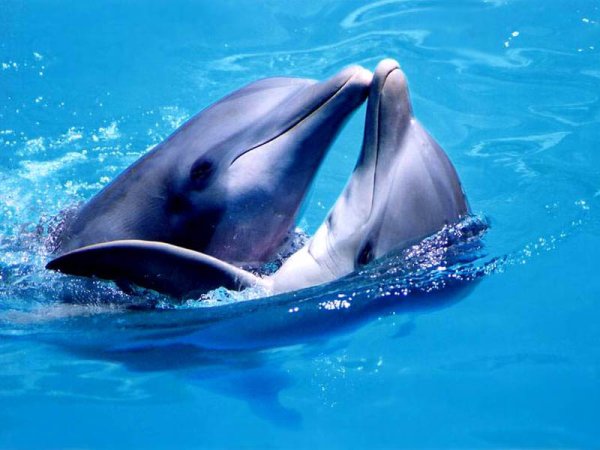
Dolphins are found in many seas and oceans of the world, including the Black Sea.
Dolphins live up to 75 years, most often about 50, in captivity usually about 30. With the help of its 88 teeth, the Black Sea dolphin eats about 30 kg of fish per day, the mass of dolphins is up to 500 kg. The body temperature of a dolphin is the same as that of a person - 36.6 degrees. The gestation period of dolphins is about 12 months. The female dolphin usually brings one calf 50-60 cm long and carefully guards it for some time.

When you mention a dolphin, you are more likely to think of the species Bottlenose Dolphin (Tursiops truncatus). Bottlenose dolphins owe their popularity partly to numerous references in cinema and fiction and their high ability to learn.
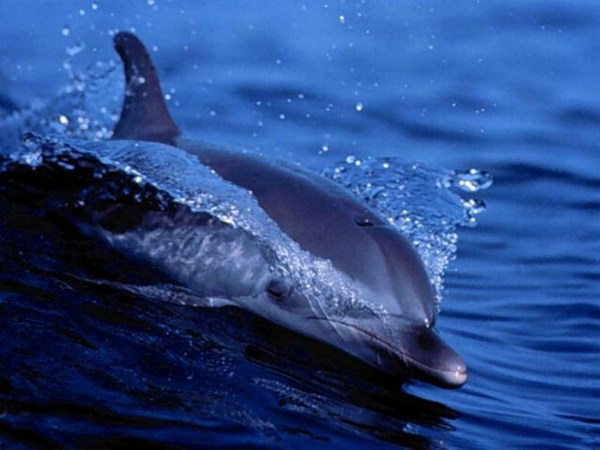
The skin of dolphins is a miracle of nature, they are able to dampen the turbulence of water near the surface of a fast-swimming body, which reduces the speed of movement - submarine designers learned from dolphins, creating artificial skins for submarines. And the feeling of dolphin skin to the touch is completely unusual, and also brings joy: it looks dense, like it’s made of plastic, but when you run your palm over it, it’s tender and soft, it seems like thin silk.
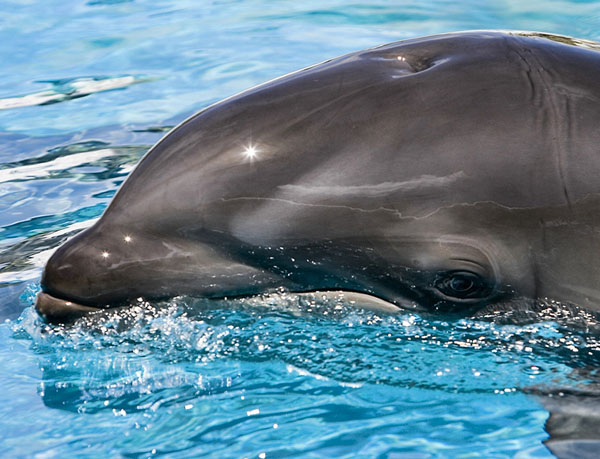
When dolphins began to be studied and trained in the middle of the last century, the first results of this work seemed so unusual, and even surprising (they talked about it a lot, wrote about it and made films) that a legend gradually developed about the unusually high intelligence of dolphins; one could often hear that they were no more stupid than a person, only their minds were different.
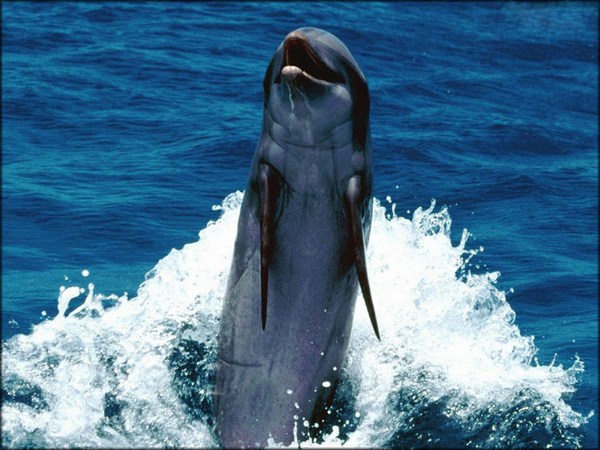
The brain of an adult dolphin weighs about 1,700 grams, while that of a human weighs 1,400. A dolphin has twice as many convolutions in the cerebral cortex. At the same time, there are relatively few neurons per cubic millimeter of its substance (less than in the brain of primates).

The results of studies on the behavior and physiology of the brain of dolphins are very contradictory. Some put their ability to learn at about the level of a dog and show that dolphins are very far from chimpanzees. Research on the communication methods of dolphins, on the contrary, leads to the conclusion that we have not yet come close to understanding this form of life in natural conditions and it is simply incorrect to compare the level of intelligence of dolphins and chimpanzees. One property of the dolphin brain is completely unique: it never really sleeps. The left and right hemispheres of the brain sleep alternately. The dolphin needs to come to the surface from time to time to breathe. At night, the waking halves of the brain are responsible for this, in turn.

The language of dolphins can be divided into 2 groups: Body language (body language) - various poses, jumps, turns, various swimming methods, signs made by the tail, head, fins.
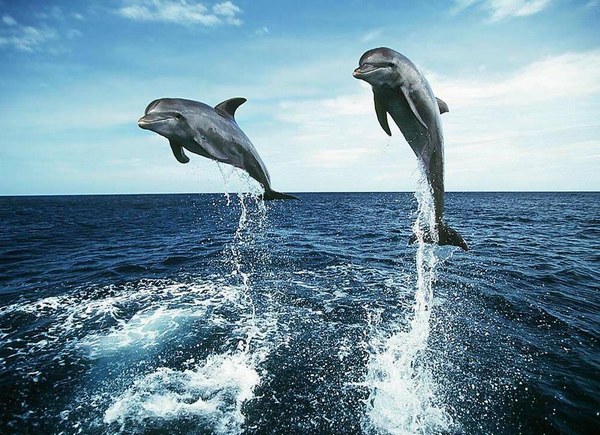
The language of sounds (language itself) is a sound signaling expressed in the form of sound impulses and ultrasound. Examples of such sounds include: chirping, buzzing, squealing, grinding, clicking, smacking, squeaking, popping, squeaking, roaring, screaming, screaming, croaking, and whistling.
The most expressive are whistles, of which dolphins have 32 species. Each of them can denote a specific phrase (signals of pain, anxiety, greetings and a calling cry “come to me,” etc.). Scientists studied dolphin whistles using the Zipf method and obtained the same slope coefficient as that of human languages, that is, they carry information. Recently, about 180 communication signs have been discovered in dolphins, which they are trying to systematize, compiling a dictionary of communication between these mammals. However, despite numerous studies, it has not been possible to completely decipher the language of dolphins.
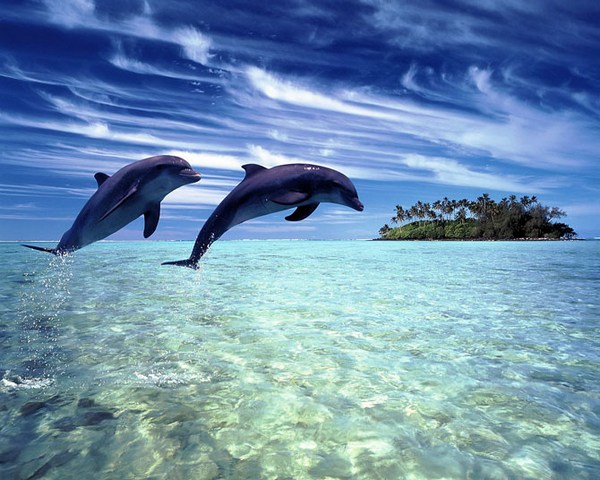
Each dolphin has its own name, to which it responds when its relatives address it. This conclusion was reached by American scientists, the results of which were published in the Bulletin of the US National Academy of Sciences (PNAS). Moreover, experts who conducted their experiments in the American state of Florida found that the name is given to the dolphin at birth and is a characteristic whistle.
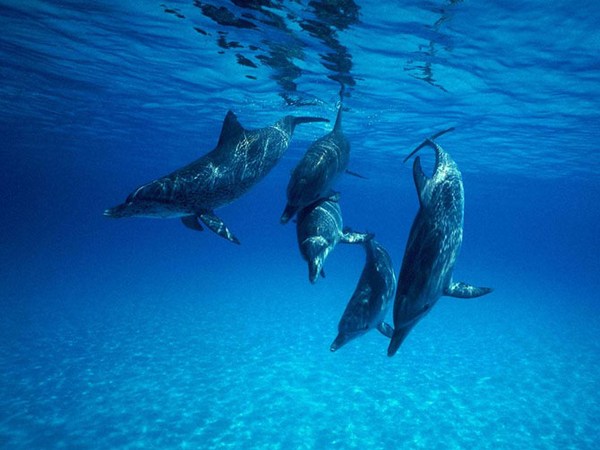
Scientists captured 14 light gray bottlenose dolphins in the wild and recorded the various sounds these mammals made as they communicated with each other. Then, using a computer, “names” were extracted from the records. When the name was “played” for the flock, a specific individual responded to it. The dolphin’s “name” is a characteristic whistle, the average duration of which is 0.9 seconds.
Everyone has heard that sometimes dolphins and other whales wash ashore. Sometimes this happens due to illness, poisoning or injury. There is another hypothesis that explains the reason for such strange behavior of dolphins: it turns out that with a certain shape of the coast, composed of certain types of sediment, among the cacophony of sounds generated by the surf, a sound sometimes arises that exactly corresponds to the cry of a dolphin for help. Animals, hearing these sounds, instinctively rush to help - and end up on the shore.
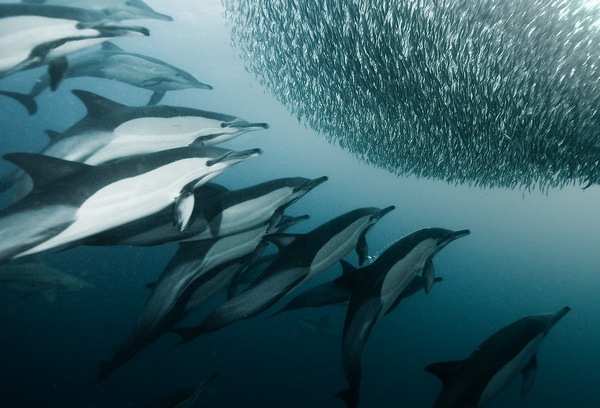
Dolphins eat fish. A lot of fish: each member of the flock should eat 10-30 kilograms per day. Dolphins are warm-blooded and need to maintain a high body temperature, sometimes in very cold water. The subcutaneous layer of fat also helps with this - it acts as a heat insulator and source of energy for the intracellular oven: burning fats and carbohydrates with the release of thermal energy. Fuel reserves need to be replenished all the time, so they constantly hunt. They catch up with a school of fish - no one in the sea swims faster than them - and surround it. If this happens very close to the shore, the dolphins form a semi-ring and press the fish to the beach; compressing their hunting formation, they push the fish into the shallowest water and eat it there - while they swim into the very waves of the surf, so shallow that their dorsal fins stick out of the water, and their pectoral fins touch the sand at the bottom.
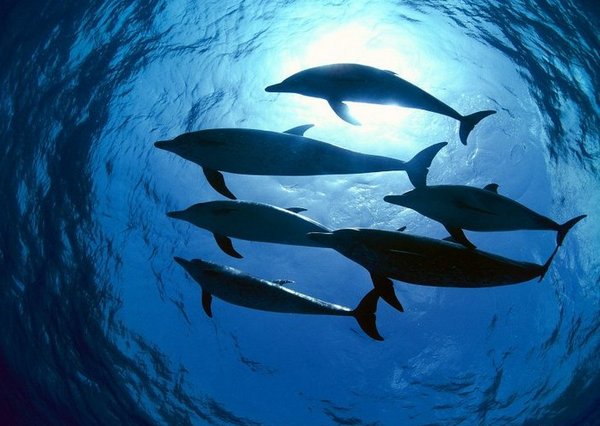
Having surrounded a school of fish further out into the sea, the dolphins do not rush, each individually, after the prey, but organize the school in a ring, preventing the fish from scattering, and one by one plunge into the school. Having caught prey, they return to their place in the pen.
Where there are fish, there are dolphins. Along the Black Sea coast, fish are most plentiful in spring and autumn - when schools of mullet and anchovy go to the Azov Sea for summer feeding, or return to winter in the Black Sea - along the coast of the Caucasus. Therefore, dolphins most often appear here in April-May and September-October. And in the Kerch Strait itself - the gateway to the Sea of Azov - hundreds of dolphins stand at the outpost, meeting migrating fish stocks.

In summer, bottlenose dolphins also often come straight to the beach - they are more often seen in the early morning or afternoon - perhaps because there are fewer swimmers at this time.
Dolphins live in schools, in which everyone is relative, which is why their mutual assistance is so well developed. They always help a weakened dolphin stay near the surface so that it does not choke; There are stories of how dolphins came to the aid of drowning people. They never act hostile. Dolphins learn tricks very quickly - they only need one correct execution of an exercise on a signal, for which they are rewarded with a fish, so that the skill is fixed in memory. True, they also easily forget their skills if the coach forgets to reinforce a useful habit.
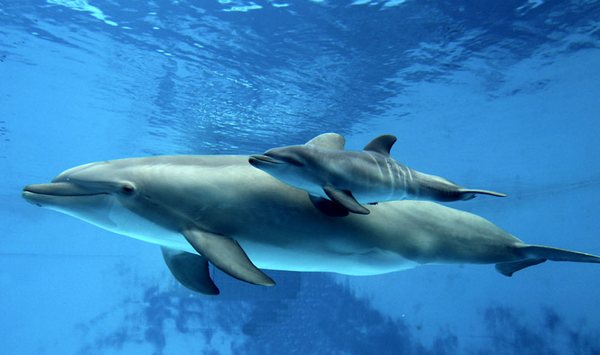
Dolphins live for about 30 years. Dolphins are born approximately once every two years. At this time, the dolphin tries to jump high so that the calf can take its first breath. Dolphins are very touching parents, caring for their young for about five years. And even when reaching puberty, the cub still remains strongly attached to its mother and tries to follow her everywhere.
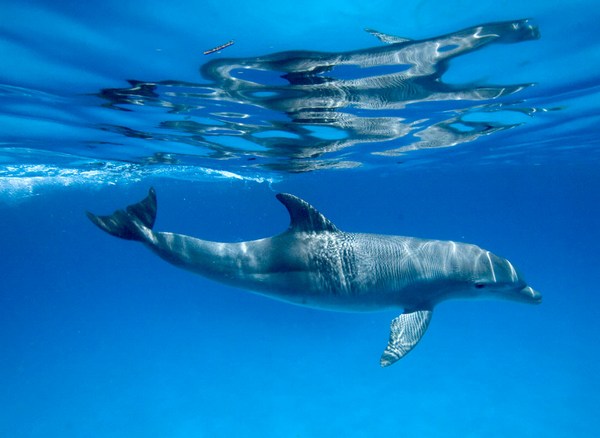
For a long time, scientists were puzzled by the question of how dolphins sleep. After all, in the sea you can easily drown or become a victim of attack by other predators. However, it has now turned out that the sleep of dolphins is not similar to the sleep of ordinary animals - during sleep, one hemisphere of the dolphin rests, and the other is awake. Thus, the dolphin is always in control of the situation and, at the same time, gets complete rest.
Definitely, something makes us treat dolphins differently than other animals - “friends of man”... Friendly, cheerful, cute... They are really friendly and curious: they are not afraid to swim up and play with a person, although more often - or not pay attention to people, or simply swim away - they have their own worries at sea. Maybe it's the dolphin's smile? After all, they always smile - for some reason, that’s how their face is structured (I don’t even want to call it a muzzle!). And this smile with big eyes is one of those smiles that makes us involuntarily smile back - not all people know how to smile like that.

Aquatic mammals of the suborder of toothed whales, closely related to porpoises. Dolphins, like all cetaceans, breathe air, periodically rising to the surface to inhale through a single modified nostril - a blowhole located on the crown of the head. They feed primarily on fish and squid, although some species prefer shrimp and other crustaceans, and killer whales also eat sea turtles, aquatic mammals and birds. In most dolphins, males are larger than females and in some species they have a higher dorsal fin. After a gestation period of 12 to 16 months, depending on the species, a single calf is born. The mother feeds it underwater with milk for at least six months, and sometimes up to two years, starting to wean it from the nipple after 6-18 months. Individuals up to 50 years old are known, although most species have a maximum lifespan of 20-25 years.

Species of the dolphin family (Delphinidae) They live in all open seas and sometimes enter the mouths of large rivers. Representatives of the family of freshwater, or river, dolphins (Platanistidae) have a much more limited distribution. For the most part they inhabit inland fresh water bodies, although some of them can penetrate brackish-water estuaries and even coastal zones of the seas. The family Stenidae includes species that live in seas, fresh waters, or both. Externally, dolphins are distinguished primarily by their protruding beak, which is clearly demarcated from the forehead. The exception is a few species with a convex, spherical forehead. Depending on the species, dolphins have from 2 to 250 conical teeth. The dorsal fin, if present, is usually crescent-shaped rather than triangular; if it is not curved, then it is very high, like that of a male killer whale. Freshwater dolphins are distinguished by the fact that their neck vertebrae are divided, like those of land mammals, rather than fused into a single bone. Some species of this family, in addition to conical teeth, have molar-shaped teeth, i.e. close in structure to the indigenous ones. The dorsal fin is usually very low, in the form of a ridge; only in the Laplatan dolphin it is the same as in the delphinids. Most dolphins live in schools and can, like the common dolphin, form huge aggregations. However, their groups are usually small: from 2-3 to approximately 100 individuals. At least some species appear to have a distinct social organization. Dolphins are generally very active and often swim extremely fast, occasionally jumping out of the water. Some species, such as the long-snouted dolphin, even perform intricate figures in the air, while others like to swing on the waves diverging from the bow of a moving vessel. Most dolphins have a wide repertoire of sounds produced. Firstly, these are impulse signals of two main types: echolocation and expressing an emotional state. Secondly, dolphins make monotonous sounds that resemble a whistle. In individuals of some species, its frequency is individual and is used to recognize each other by members of the pack. In addition, the volume and frequency of the whistle reflect the emotional state of the dolphin. In some individuals, auxiliary monotonous signals are noted - also stereotypical and characteristic of each of them. Non-local pulses, called chirps, come in many types that are typically species-specific rather than individual-specific. Attempts are being made to find a connection between various chirps and the behavior of dolphins, but all chirps are for the most part similar to each other and smoothly transition into each other. Although such signals reflect a particular emotional state, it is clearer to other dolphins than to human observers, and there is no evidence that these sounds actually constitute language in the human sense. The same can be said for monotonous whistles.
DOLPHIN FAMILY
This family includes many species of sea dolphins. Below we will consider some of its most famous and rare representatives. Bottlenose dolphins (Tursiops). Of the species of this genus, the most famous is the Atlantic, or simply bottlenose dolphin (T. truncatus), widely distributed in warm waters all over the world. Sometimes several of its subspecies are distinguished, which some scientists consider to be independent species. Bottlenose dolphins are widely used for research and training. Their body is grayish, up to 3.6 m long (in captivity it is rarely more than 2.4 m). All bottlenose dolphins eat fish; on each side of the upper and lower jaws they have approx. 20-25 teeth. Although sexual maturity occurs at 7-8 years, at least the males reproduce most actively, becoming approximately twice as old. Pregnancy lasts about a year, and the cubs are fed milk until 18 months, although they begin to consume solid food a year earlier. Immediately after birth, the baby floats to the surface on its own to breathe in air. For the first few months he stays close to his mother. Her fast swimming does not violate this close physical connection, since the female, by slightly increasing her energy expenditure, generates hydrodynamic forces, with the help of which she ensures the movement of both herself and the calf. Bottlenose dolphins usually migrate in small schools of fewer than a dozen individuals, but sometimes several hundred animals can be seen at once. It is these dolphins that most often flash along beaches, in shallow bays and estuaries, although in cold waters you can often see common porpoises there. Wild bottlenose dolphins have been observed in New Zealand, Florida and Scotland regularly playing with people swimming. Such individuals were always found in the same areas and, it seems, were not at all afraid of humans, even allowing themselves to be touched. But such cases are rare. Bottlenose dolphins often bob on the waves in front of the bows of sailing ships - usually this is the closest contact with humans that they allow in nature. Sound signals and echolocation abilities have also been studied, mainly in bottlenose dolphins. They most often tried to attribute the existence of language, but this hypothesis has not yet been confirmed. The white-sided dolphin (Delphinus delphis) from the genus of common dolphins is one of the most common members of the family in the Mediterranean Sea. This is a very beautiful dolphin, with black circles around the eyes and yellow and gray markings on the sides, the pattern of which resembles the letter "X". Sometimes in the open sea you can see a huge number of these slender, bright animals at once. Squirrels inhabit warm and temperate seas around the world. They are usually divided into three subspecies: one in the Atlantic and, possibly, the Indian Oceans, another in the Pacific and a third in the Black Sea. Independent, although closely related, forms are sometimes isolated for South Africa, Japan and the Red Sea. Female white-sided moths give birth to a calf approximately 3 times every 4 years and feed it for 4-5 months. It is believed that the maximum lifespan of this species is more than 20 years. Short-headed dolphins (Lagenorhynchus) are represented by several species: depending on the classification used, their number can reach up to six. Representatives of this genus usually inhabit colder waters than other dolphins, and some species even reach pack ice. One of them, the Pacific striped dolphin (L. obliquidens), is regularly exhibited in several aquariums and is remarkable for its ability to jump over a high-hanging bar. When short-headed dolphins live with other species of the family, they are very friendly and caring towards other people's offspring. Their flocks are not as large as those of white sideds, but sometimes number up to 1,500 individuals. A distinctive feature of the genus is a distinct groove on the beak, but the beak itself is not as long as many other dolphins and is not as noticeable to the casual observer. As a result, from a distance they can be confused with porpoises. Dolphins (Stenella) are very diverse in color, number of teeth and other structural features. This is the largest genus of the family in terms of the number of species, and many of them are quite common. Experts believe that the taxonomy for this group is poorly developed. The number of teeth, depending on the species, ranges from 37 to 50 on each side of each jaw. The coloration varies from light spots on a dark background to similar to the pattern of the common dolphin, having a dark back and stripes around the head and on the sides on a light background. Some dolphins are long and slender, with a very elongated snout, while others have a more massive body and a much shorter snout. Most species live far offshore in tropical and temperate waters around the world. They are good swimmers and often bob on the waves in front of ships. The Atlantic spotted dolphin (S. plagiodon) and its close eastern Pacific relative S. graffimani are sometimes shown in aquariums. The first species is a spectacular jumper, often jumping over the head of the person feeding it. In captivity, dolphins feed on fish, but in nature their favorite food is squid. The striped dolphin (S. caeruleoalba) is a commercial species in Japan; sometimes it is shown to the public. Pilot whales, or ball-headed dolphins (Globicephala), are a very large species: the animals reach a length of 6.5 m and a mass of approx. 2 tons. They are characterized by a huge pillow on the forehead containing viscous fat. The body is black with a white mark on the chest and the same line below the middle of the belly. This pattern, as well as the light "saddle" on the back behind the dorsal fin, typical of some forms, are not always clearly defined. There are three types. Pilot whales typically live in warm to temperate waters, but may migrate into relatively cold areas during the summer. It has been proven that they have seasonal migrations, carried out in flocks of up to several hundred individuals. They all often move forward, simultaneously emerging and submerging, as if at the command of the leader. Apparently, the flocks sometimes stop to rest, but even then their formation usually remains military-correct, and the animals surface to take a breath as synchronously as during movement. Sometimes entire flocks of pilot whales are thrown onto land and die. The reasons for this behavior are unknown. Pilot whales feed almost exclusively on squid, but in captivity their diet may include fish. Females usually reach sexual maturity at 6-7 years, and males sometimes only at 12 years. Pregnancy lasts approx. 16 months Although the cub can eat solid food from 6 months of age, milk feeding continues until 2 years of age. The killer whale (Orcinus orca) is the largest and most beautiful species of dolphin, distinguished by its striking black and white pattern; their weight is up to 8 tons. This species inhabits all seas, from the coldest to the warmest, staying mostly close to the shore. This is the only cetacean that, in addition to fish, feeds on aquatic mammals, sea turtles and birds. Killer whales are characterized by pronounced sexual dimorphism. Males reach a length of 9 m - a meter and a half more than females. In addition, their dorsal fin is high and almost straight, while in adult females it is approximately half as low and curved. Unlike most dolphins, the killer whale's pectoral flippers are not pointed and sickle-shaped, but wide and paddle-shaped. These animals are very voracious and hunt in packs, attacking not only small animals, but also huge baleen whales, from whose bodies they tear pieces of meat. In addition to warm-blooded animals, killer whales eat a large amount of fish, which actually forms the basis of their diet. Despite the bad reputation of these animals, called "killer whales", there is no conclusive evidence of their attacks on humans. In contrast, in captivity, orcas are very docile and allow people to ride on their backs, and the trainer can put his head into their open mouth without fear. They are highly trainable, able to jump almost completely out of the water and perform complex sets of exercises. The small or black killer whale (Pseudorca crassidens), with large sharp teeth, is very similar to the common killer whale, and in size and color it resembles a pilot whale, differing in a much more streamlined body shape. There are no records of this species attacking warm-blooded marine animals, but its feeding method is unusual: the killer whale often grabs very large fish and tears them apart in much the same way as the common killer whale tears seals, small dolphins or porpoises. Like pilot whales, these animals sometimes wash ashore. The gray dolphin (Grampus griseus) is very similar in appearance to the pilot whale, but differs in the presence of teeth, usually only on the lower jaw, a deep groove on the forehead and a large number of scars scattered throughout the body. Males have especially many of them: it is believed that in most cases these are traces of battles with relatives. The markings are so distinctive that they were previously mistaken for being part of the gray dolphin's natural pigmentation. This species feeds mainly on squid and lives in all seas except the polar ones.
Other dolphins. The dolphin family includes many rare or little-known species. The pygmy killer whale (Feresa attenuata) looks very similar to the pygmy killer whale, but is much smaller. It is found only in the South Pacific, off the coasts of Japan and Senegal, and is rarely kept in captivity. The Irrawaddy dolphin (Orcaella brevirostris) has two subspecies. One lives in the Irrawaddy River in Burma, and the other in the seas from the Bay of Bengal to Borneo and Java. The beakless or broad-snouted dolphin (Peponocephala electra) is found in the tropical waters of the Atlantic, Pacific and Indian oceans. There are two species of dorsal-finned whale dolphins (Lissodelphis): the northern one (L. borealis) is found in the North Pacific Ocean, and the southern one (L. peroni) is found in the temperate zone of the Southern Hemisphere. The genus of beaked, or motley, dolphins (Cephalorhynchus) includes several southern, mainly cold-water species. They are small in size and characterized by a bright black and white color. The Sarawak dolphin (Lagenodelphis hosei) is known only from one skeleton found on the island of Borneo.
FAMILY STENIDAE
There is no Russian name for the family Stenidae. It includes both freshwater and marine forms with characteristic structural features of the respiratory tract. Large-toothed dolphins (Steno) are a monotypic genus. Its only species, the common dolphin (S. bredanensis), is widespread in temperate and tropical seas, where it is found only offshore. Its snout is long, but not as sharply demarcated from the forehead as in most dolphins, but rather smoothly passing into the upper part of the head. The dark gray coloring of the back gradually becomes lighter on the sides and becomes very light on the belly. The species got its name because of its teeth with a ribbed, uneven surface. The biology of the animal has been little studied, but it is known that it feeds on fish, squid and octopuses. Although these dolphins are considered a rare species, significant numbers of them are sometimes captured around the Hawaiian Islands for studies of vocalizations and local migrations. Like representatives of the dolphin family, they emit both monotonous whistles and various pulsed signals. The genus Sousa includes five species found off the coasts of Western and Southern Africa, China, Borneo and the Indian Ocean. In appearance, these are typical dolphins with a snout quite clearly demarcated from the forehead. Little is known about their biology. They feed mainly on fish, live mainly in the sea, but close to the shore and can enter rivers. The Chinese white or humpback dolphin (S. chinensis) lives mainly in fresh waters. There are two species of long-beaked dolphins (Sotalia). Both are found in South America, but in different ecological niches. The Guiana dolphin (S. guianensis) inhabits coastal sea waters and estuaries in northeastern South America from Rio de Janeiro to Venezuela. The Amazon dolphin, or tukashi (S. fluviatilis), lives only in the fresh waters of the Amazon basin and often swims into the flooded jungle during floods. Long-beaked dolphins feed on fish, but the details of their biology are still little known.
FAMILY OF FRESHWATER OR RIVER DOLPHINS
This family consists of four genera, one species in each. Three of them are exclusively freshwater. The fourth, South American, species lives in estuaries and can migrate along the sea coast during the winter months. Amazonian Inia, or Bouto (Inia geoffrensis). Young animals are light gray, but with age they gradually acquire a pinkish tint. Their very long snout is covered with stiff hairs or bristles, which apparently serve a sensory function. Amazonian Hoi have an average of 25-27 teeth on each side of each jaw. The front teeth are pointed, conical, and the back teeth are somewhat similar to molars. Two types of teeth and unfused cervical vertebrae are primitive features for cetaceans. Inia feeds on fish, including those covered with bony plates, and its teeth are often heavily worn, apparently from chewing hard food. According to some reports, inia may have several subspecies. These freshwater cetaceans are common in the Amazon and Orinoco river basins and during floods they even penetrate into flooded forests, where they swim between the trees. When searching for food on the bottom, inias often turn belly up, perhaps because their thick cheeks would otherwise obstruct their view. Studies of the sounds they make have shown the presence of a rich repertoire of pulse signals, including echolocation signals, used to search for food and explore the environment; however, no monotonal whistles were detected. The Gangetic dolphin, or susuk (Platanista gangetica), lives in the Indian rivers Indus, Ganges and Brahmaputra. He is apparently blind, as his eyes lack a lens. However, the animals compensate for this deficiency by developing an unusual cup-shaped depression on the skull, which resembles an enlarged reflector of a flashlight and undoubtedly directs and concentrates echolocation signals. Studies of several living specimens of this species have demonstrated their apparently exceptional echolocation abilities. The Gangetic dolphin is believed to feed on freshwater shrimp and burrowing fish, which it catches by probing the bottom with its very long jaws. Surprisingly, this animal usually swims on its side. The Chinese lake dolphin (Lipotes vexillifer) lives in the central-eastern part of China in the Yangtze (Changjiang) and Qiangtang rivers, as well as lakes Dongting and Poyang. For a long time this species was classified as a member of the family Platanistidae, but is now often classified as an independent family Lipotidae. The animal reaches a length of 2.5 m, and the mass of one of the studied specimens was 160 kg. In appearance it is closest to the Amazonian inia. Chinese lake dolphins feed on fish, in particular catfish, which they pull out of the bottom mud with their long beaks. They usually move in pairs, forming a larger group of about ten individuals. The Laplatan dolphin (Pontoporia [] blainvillei) is unique among species of the family Platanistidae for several reasons. It lives not only in the large La Plata River in South America, but also emerges from it into purely marine coastal waters. Some features of its skeleton and the good development of its dorsal fin are also unusual. Some taxonomists have proposed placing it in the family Delphinidae. This small dolphin feeds on fish, shrimp and cephalopods.
see also
Niramin - Nov 26th, 2015
Dolphins are mammals of the dolphin family from the order Cetacea. There are about 40 types of them. The largest species is the killer whale.
What do dolphins look like?
They have a bare, streamlined body, an elongated muzzle, and a pointed dorsal fin. The eyes are small and lack sharp vision. Skin coloring can be of two types: plain - gray, pink, or contrasting - when large areas are painted black and white.
Depending on the species, they come in different weights: from 40 kg to 500 kg. The body length reaches 1.2 m, but the killer whale can be up to 9 m and weigh 7.5 tons.
They may not sleep for up to 5 days, but this does not affect their health. If they sleep, then very little. If they sleep for a long time, they can suffocate and die. When they rest, one half of the brain is asleep, the other is awake, then they can breathe.
Dolphins are warm-blooded animals. Their body temperature is the same as a human's, 36.6°C.
They have echolocation - they determine the location of an object by capturing a reflected sound wave. They communicate between relatives using sounds of varying durations, and warn about impending danger with sound signals.
Where do dolphins live
They live in almost all the seas of the world and in shallow tropical latitudes of the oceans. You can also find it in the Black Sea. Only 5 species of river dolphins live in rivers.
Dolphin feeding
They feed on small fish - anchovies, sardines, squid, crustaceans. The killer whale prefers walruses, seals and sea lions. Interestingly, with 40 teeth, they swallow all prey whole without chewing.
Reproduction and lifespan of dolphins
Mating occurs throughout the year. The pregnancy is carried by a female dolphin, depending on the type of animal, from 9 to 16 months. Only one cub is born. The mother immediately pushes the newborn to the surface of the water so that he takes his first breath. They are fed with mother's milk for six months.
The maximum life expectancy is 50 years. In captivity, their life is shortened to 25 years, as the animals are often used to perform acrobatic stunts in dolphinariums.
See a gallery of photographs of different dolphins:










 Photo: Long-beaked dolphin
Photo: Long-beaked dolphin  Photo: Long-snouted common whitetail
Photo: Long-snouted common whitetail  Photo: Whale dolphins
Photo: Whale dolphins  Photo: Orcas
Photo: Orcas  Photo: Large-toothed dolphin
Photo: Large-toothed dolphin  Photo: Variegated dolphins
Photo: Variegated dolphins  Photo: Gray dolphin
Photo: Gray dolphin  Photo: Bottlenose dolphins
Photo: Bottlenose dolphins  Photo: Beakless dolphins
Photo: Beakless dolphins  Photo: Humpback dolphin
Photo: Humpback dolphin  Photo: Grindas
Photo: Grindas 

 Photo: frolicking dolphins
Photo: frolicking dolphins
Video: Diving and dolphins are an explosive positive!!!
Video: Dolphins bring POSITIVITY from an eternal “smile”, friendship, loyalty.
Video: Tenerife, Canary Islands. Puerto de la Cruz. Loro Parque. Orca show Part 1
Video: Grinds
Each dolphin in the ocean has its own name, which it responds to when its relatives call it. He receives it immediately as soon as he is born, and it is a characteristic whistle lasting 0.9 seconds. Dolphins not only call each other by name, but also introduce themselves when meeting strangers. And identifying a relative by voice without seeing him is a piece of cake for them.
Dolphins are mammals from the family of toothed whales of the cetacean order. There are about forty species of these animals on the planet, and you can see them anywhere. Most dolphins prefer to live in tropical and subtropical latitudes, but there are some that like colder waters, so you can see them near the Arctic, and some species are found both there. For example, although the white-beaked dolphin lives mainly in the North Atlantic, it can often be seen off the coast of Turkey.
Most members of the family (for example, bottlenose dolphins, white-beaked dolphins) are marine inhabitants, but there are four species that prefer to live in fresh river or lake water. The river dolphin lives in Asia, as well as in the waters of the South American Amazon and Orinoco rivers.
Unfortunately, if previously representatives of this family were often encountered, now the river dolphin, due to loss of habitats, environmental pollution, decreased food supply and small populations, has practically disappeared and is listed in the Red Book.
Description
The length of dolphins ranges from one and a half to ten meters. The smallest dolphin in the world is Maui, which lives near New Zealand: the length of the female does not exceed 1.7 meters. The white-faced dolphin, about three meters long, is considered a large inhabitant of the deep sea. The largest representative is the killer whale: males reach ten meters in length.
It is worth noting that males are usually ten to twenty centimeters longer than females (the exception is killer whale dolphins - here the difference is about two meters). They weigh on average from one hundred fifty to three hundred kilograms, the killer whale weighs about a ton.
The backs of sea dolphins can be gray, blue, dark brown, black and even pink (albinos). The front part of the head can be either plain or white (for example, the white-faced dolphin has a white beak and the front part of its forehead).
In some species, the front mouth is rounded and there is no beak-shaped mouth. In others, small ones, the head ends in an elongated mouth in the shape of a flattened “beak”, and the mouth is shaped in such a way that it seems to people watching them that they are always smiling, and therefore they often have an irresistible desire to swim with dolphins. At the same time, the impression is not spoiled even by the huge number of teeth of the same cone shape - dolphins have about two hundred of them.
Thanks to their elongated body and smooth, elastic skin, these animals hardly feel the resistance of the water while moving. Thanks to this, they are able to move very quickly (the average speed of a dolphin is 40 km/h), dive to a depth of about one hundred meters, jump out of the water nine meters in height and five in length.
Another unique feature of these marine mammals is that almost all species of dolphins (with the exception of the Amazon river dolphin and several other species) have good vision both underwater and above the surface. They have this ability due to the structure of the retina, one part of which is responsible for the image in the water, the other - above its surface.
Since whales and dolphins are relatives, like all representatives of cetaceans, they are quite capable of staying under water for a long period. But they still need oxygen, so they constantly float to the surface, showing their blue muzzle and replenishing air reserves through the blowhole, which closes under water. Even during sleep, the animal is fifty centimeters from the surface and, without waking up, swims out every half a minute. 
Way of life
Dolphins live in schools and do not tolerate loneliness very well. Although they do not have a leader, they carry out all actions in coordination: they hunt together, raise children, have fun, performing amazingly beautiful jumps one after another.
The dolphin is considered one of the most intelligent mammals on our planet: the weight of its brain is 1700 grams, which is three hundred grams more than a human, and the convolutions in the cerebral cortex are also twice as large. This explains their highly developed social consciousness, ability to sympathize, readiness to help sick and wounded relatives, as well as drowning people.
Dolphins help quite actively: if one of the members of the pod is injured or barely stays afloat, they support him near the surface so that he cannot drown and choke. They do the same in relation to a person, also helping to get to the shore. Some scientists explain why dolphins do this by caring for the population: each individual in the pod is valuable - and everything must be done to save its life.
Language
To communicate, animals use gestures (turns, jumps, various swimming styles, head, fins, tail), as well as voice: the sounds of dolphins are about 14 thousand signals, and everyone has heard about the songs of dolphins. These unique animals are capable of perceiving vibration frequencies of up to 200 thousand per second, while the human ear is up to 20 thousand.
They are also four times more capable of analyzing dolphin sounds by separating frequencies from each other (a lot of research has been done lately to find out why dolphins have these abilities). Communication occurs mainly with the help of ultrasound (it is especially convenient for them to use it to transmit sound over vast distances).
Dolphin songs are not only ultrasound: the sounds of dolphins often sound at a medium frequency and are expressed by clicks, creaks, and whistles (studies have shown that they perceive their speech as hieroglyphic pictures).
There are two types of dolphin sounds:
- Sonar or echolocation - animals hear the echo of a beating sound and identify it;
- Whistling or chirping - these sounds of dolphins are used for close communication with relatives and the animals express their emotions with them. Scientists have counted about 186 different types of “whistles”, which, like human speech, contain sounds, syllables, words, phrases, paragraphs, context and dialect.
Nutrition
Dolphins' diet is based on fish, squid, and shrimp (some dolphins in the ocean are quite capable of diving to a depth of 260 kilometers to catch their favorite prey); killer whales eat marine mammals and birds.
They catch fish in different ways. Sometimes the whole school of dolphins searches for her, sometimes in a separate group or they send a scout to look for her. If the hunt takes place in the open sea, dolphins surround a large school of fish, crowding them into a heap, after which they take turns diving there and feeding. If they are fishing near the shore, the strategy is somewhat different: a school of dolphins drives the schools towards land, after which the fish are easily caught in shallow water.
Reproduction
The ability to reproduce in females appears between the fifth and twelfth years of life, in males - between the ninth and thirteenth. Their pairs are unstable and the animals change partners every time. 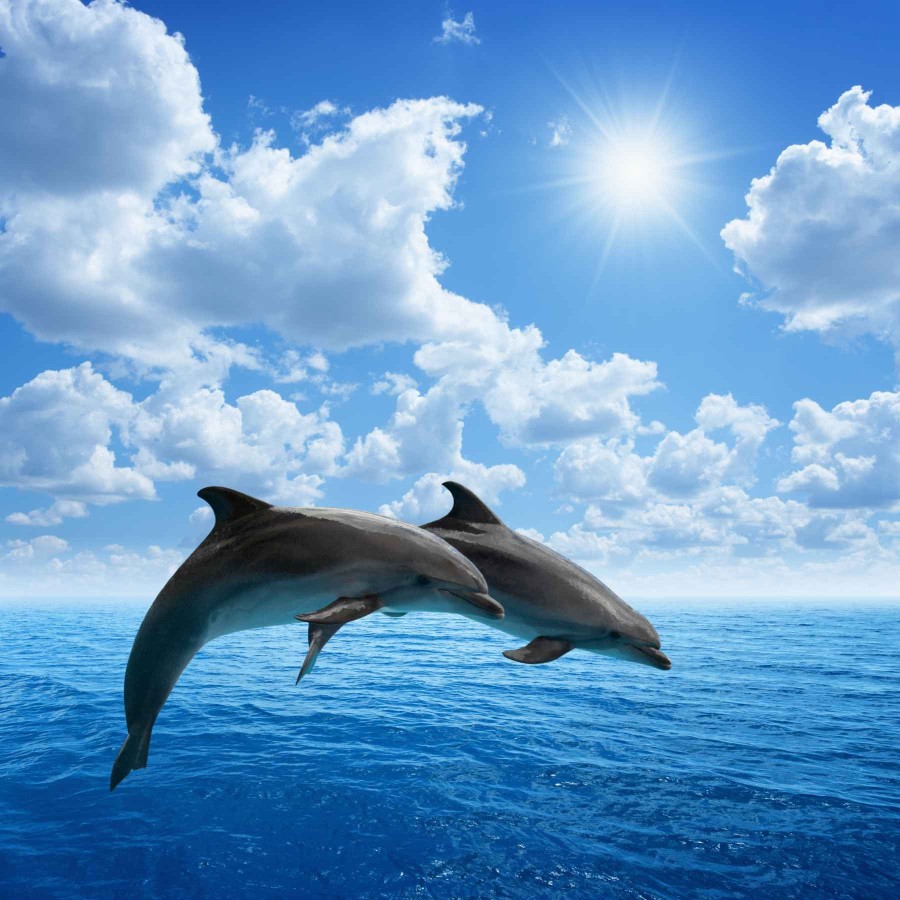
Exactly how long pregnancy lasts has not been established; the period is estimated to range from ten to eighteen months. When giving birth, the female is very close to the surface so that, as soon as the baby is born, she raises her tail high, giving him the opportunity to take a breath of air before falling into the water.
Usually one baby is born, about half a meter long, and until six months the mother feeds it with milk and protects it. Newborn babies usually do not fall asleep during the first month of their life and do not allow their mothers to sleep, swimming around them and surfacing every thirty seconds, forcing them to be constantly on alert.
Relationships with people
People and dolphins have a long and complex history: until recently, animals were actively hunted, which led to the complete and partial extinction of some species. After fishing was banned, the situation got better, but a new trend emerged: catching these animals for show (especially since they are very smart and catch everything on the fly) and giving people far from the sea the opportunity to swim with dolphins. It should be noted that the idea is not the best, because if in natural conditions the inhabitants of the sea live from thirty to fifty years, in captivity - only seven.
Their rapid death is primarily influenced by an overly passive lifestyle, even despite constant training to participate in the show, extremely limited space and water quality: the lack of a full range of nutrients and minerals they need.
Recently, people and dolphins have learned to interact better (primarily this concerns humans, since these animals are sociable, friendly and peaceful). Moreover, communication with these mammals benefits almost everyone: by giving the opportunity to listen to the songs of dolphins, communicate, stroke the blue back, feed fish, swim with dolphins, psychotherapists and doctors effectively use them to treat diseases in children such as cerebral palsy, early childhood autism, etc.
Dolphins are mammals that are related to toothed whales, breathe with lungs and feed their babies with milk. They live in sea waters and oceans, sometimes found in rivers with access to the sea.
A dolphin is considered a warm-blooded animal; its body temperature must always be within 36.6 degrees C. To reach this point, it must eat about 30 kg of food per day. Dolphins have more than 100 teeth, which do not take any part in chewing food. Animals swallow food whole.
Scientists have not yet fully learned the entire process of eating food, how these animals prepare it, and have not yet fully considered the question of what dolphins eat. Presumably, these intelligent animals created their own civilization, which is not yet possible to understand, but much is already known, which is described below.
What do dolphins eat from the first days of life?
A mother dolphin feeds her babies for the first time six hours after birth. The feeding process occurs shallow underwater. Since the baby does not have soft lips, he cannot suck on his own. Milk enters his mouth in a strong stream by injection. In the very first days of its life, a small dolphin receives mother's milk up to eight times within an hour, this lasts the whole day. Then the intervals between feedings gradually increase. 
Dolphin milk is nutritious, containing about 33% fat and 7% protein. Water and lactose make up close to 58%. Eating such food, a small dolphin grows quickly, builds up a thick layer of fat, at one and a half years old begins to try fish for the first time and gradually begins to get its own food.
What do dolphins like to eat in the seas and oceans?
In their habitats, in the seas and ocean waters, dolphins try to be where the fish are. They are very picky when it comes to food, so they have to - they don’t eat, they prefer only a certain type of food.
It’s not worth talking about the sense of taste, because very little is known about it. But knowing the characteristics of the brain and cranial nerves, one can guess about some of the taste sensations of animals and what dolphins eat. After all, they prefer only a certain type of fish. Our scientists conducted experiments and proved that dolphins have taste buds on their tongues, which means they definitely have taste sensations.
The dolphin eats fish in large quantities. He eats a lot of it in a day. Fish is his favorite food. This includes almost all types of sea fish: mackerel and herring, mackerel, saury and hake, flounder, mullet, anchovy. In addition to the above, favorite delicacies are squid, shellfish and crustaceans.
The amount of food required by adult animals is estimated at 4-5% of body weight, for nursing mothers - about 8%. It is known that beluga whales need 25-30 kg of fish per day, while bottlenose dolphins need 10-15 kg of fish products per day.
Due to the fact that dolphins are considered hunters, when feeding in dolphinariums you need to make sure that the food (prey) can move. But in captivity they are accustomed to frozen products. The favorite food for dolphins in this habitat remains squid and fish.
Dolphins have a wide range of sounds. There are several dozen of them, they are carried far into the sea and thereby help animals communicate with each other. There are moans, squeaks, whistles, clicking, chirping... You might ask, what sound do dolphins make when they eat? While eating, a sound is made - meowing.
How do dolphins get food?
The food acquisition strategy of dolphins is varied. Most often, hunting occurs in the daytime, only when there is a shortage of fish, hunting is necessary at night. Not the entire flock participates in night fishing, but only some individuals; when caught on the seabed, they lead a nocturnal lifestyle. 
While hunting in the open sea, a pod of dolphins tries to surround and compact it. Then they enter it one after another and get their fill of food. When food production occurs close to the coast, animals drive their trophy into shallow water, closer to land. They sometimes hunt for large fish alone, using their tail to throw the prey above the water, catch it in the mouth or drown it.
Dolphins are considered good hunters. They have a special structure of fins and skin, as well as a streamlined body shape. Thanks to these features, anaphiles can swim very quickly, not inferior to even the most nimble inhabitants of sea and ocean waters. The maximum speed is up to 40 km per hour, the diving depth of some species of dolphins is about 260 meters. Probably everyone knows their jumps; in the horizontal direction they are able to “fly” about 9 meters, in the vertical direction - about 5 meters.
The most amazing facts from the life of dolphins
An incredible but true romantic fact from the life of animals: scientists who studied dolphins saw how males presented gifts to their chosen ones in order to earn their favor. The bouquet was ordinary seaweed.
The dolphin's cerebral cortex has twice as many convolutions as that of humans. 
Scientists have noticed that there are close connections between dolphins in a school. They treat the elderly and relatives with care, and do not leave the wounded and sick in trouble. A female dolphin comes to the aid of another female if difficulties arise during childbirth.
